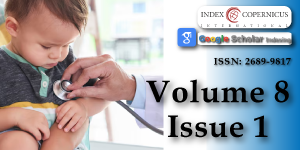Invasive Magnusiomyces Capitatus Infection in a Patient Followed for Acute Myeloblastic Leukemia: A Case Report
Main Article Content
Abstract
Magnusiomyces capitatus is a rare cause of invasive fungal infection in immuno-compromised patients. We report the case of magnusiomyces infection of the central nervous system, the lungs and sinus with a palatal lesion, in a patient treated for acute myeloid leukemia. While Magnusiomyces infections pose diagnostic and therapeutic challenges, a comprehensive understanding of their epidemiology, clinical manifestations, and microbiological aspects is essential to guide effective management. The patient improved under antifungal treatments despite a reduced sensitivity of the different antifungals to the antifungogram. The important delays between chemotherapy cycles and its reduced intensity due to the Magnusiomyces infection has made managing the anticancer treatment more challenging.
Article Details
Copyright (c) 2025 Mezdaoui I, et al.

This work is licensed under a Creative Commons Attribution 4.0 International License.
Bansal D, Davidson A, Supriyadi E, Njuguna F, Ribeiro RC, Kaspers GJL. SIOP PODC adapted risk stratification and treatment guidelines: recommendations for acute myeloid leukemia in resource-limited settings. Pediatr Blood Cancer. 2023;70(11):e30410. Available from: https://doi.org/10.1002/pbc.28087
Zhu M, Yan L, de Hoog S, Liao W, Zhang H, Zhao R. Invasive infections due to Magnusiomyces capitatus: case report and review of its prevalence in China. Mycology. 2022;13(1):76–80. Available from: https://doi.org/10.1080/21501203.2021.2000059
Kaplan E, Al-Hatmi AM, Ilkit M, Gerrits van den Ende A, Hagen F, Meis JF. Molecular diagnostics of arthroconidial yeasts, frequent pulmonary opportunists. J Clin Microbiol. 2018;56(1):e01144-17. Available from: https://doi.org/10.1128/jcm.01427-17
de Hoog S, Smith M. Ribosomal gene phylogeny and species delimitation in Geotrichum and its teleomorphs. Stud Mycol. 2004;50:489–515. Available from: https://www.studiesinmycology.org/sim/Sim50/046-Ribosomal_gene_phylogeny_and_species_delimitation_in_Geotrichum_and_its_teleomorphs.pdf
Rouis S, Khammeri I, Achour B, Achour A, Ben Sayed N, Regaieg H, et al. Invasive infection caused by Geotrichum capitatum in three patients with acute myeloid leukemia. Pan Afr Med J Clin Med. 2020;4:1–5. Available from: https://www.clinical-medicine.panafrican-med-journal.com/content/article/4/41/full/
Gao GX, Tang HL, Zhang X, Xin XL, Feng J, Chen XQ. Invasive fungal infection caused by Geotrichum capitatum in patients with acute lymphoblastic leukemia: a case study and literature review. Int J Clin Exp Med. 2015;8(8):14228–35. Available from: https://pmc.ncbi.nlm.nih.gov/articles/PMC4613086/
Tanuskova D, Horakova J, Svec P, Bodova I, Lengerova M, Bezdicek M. First case of invasive Magnusiomyces capitatus infection in Slovakia. Med Mycol Case Rep. 2017;16:12–15. Available from: https://doi.org/10.1016/j.mmcr.2017.03.004
Ortiz-Álvarez J, Reséndiz-Sánchez J, Juárez-Montiel M, Hernández-García JA, Vázquez-Guerrero E, Hernández-Rodríguez C, et al. Invasive fungal infection caused by Magnusiomyces capitatus in an immunocompromised pediatric patient with acute lymphoblastic leukemia in Mexico City: a case report. J Fungi (Basel). 2022;8(8):851. Available from: https://doi.org/10.3390/jof8080851

